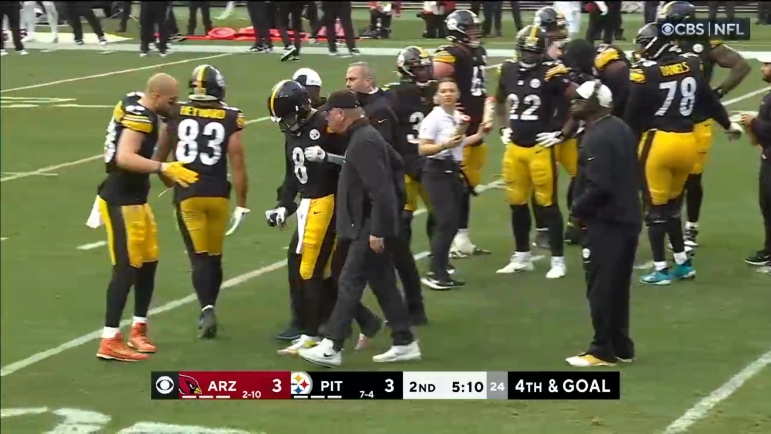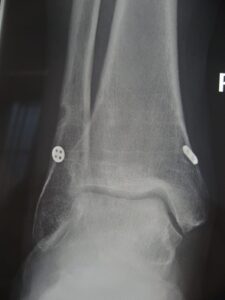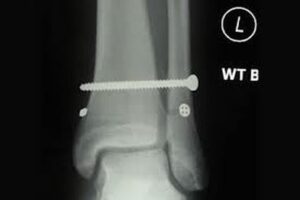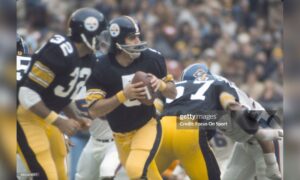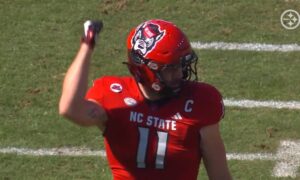Pittsburgh Steelers quarterback Kenny Pickett obviously doesn’t want to waste time getting back on the field while dealing with a Grade 3 high ankle sprain. Less than 24 hours after limping off the field at Acrisure Stadium late in the second quarter on Sunday, Pickett had already undergone surgery on his right ankle. This was confirmed by head coach Mike Tomlin when he spoke to the media a few hours later. When asked about the timeline for Pickett’s return to play, Tomlin would only say that he is ruled out for this Thursday’s game against the Patriots. He declined to give a better estimate until he heard an update from Pickett’s surgeon.
On NFL Gameday Kickoff later in the day, NFL insider Ian Rapoport reported that Pickett had undergone “tightrope surgery” and would not go on IR, with the hope that he could return by the Week 18 game against the Baltimore Ravens or even sooner.
So what is tightrope surgery and how does it accelerate the recovery from a high ankle sprain? If you need detail on the anatomy and actual injury, check out my post from yesterday here:
Want the cheat sheet? No problem. Here we go…
A high ankle sprain is a tear in the ligaments that connect the tibia and the fibula just above the bones of the ankle joint, like a tarp between two logs. A Grade 3 sprain can be severe enough that the space between the two long bones is wide enough to make the ankle joint unstable. That can mean a very long time in a boot and a return to play as late as three months later.
The tightrope surgery provides a way to surgically stabilize the ankle joint without sacrificing mobility. Using equipment developed by Arthrex, an orthopedic medical device company, the Syndesmosis Tightrope Implant System allows the surgeon to perform the entire procedure through a tiny incision on the lateral side of the ankle. Instead of using metal screws, an extremely strong suture is passed from through both the tibia and the fibula and secured on the outside edges of the two bones with metal buttons. While the surgeon needs to drill holes in each bone to pass the suture, there is no need to affix the suture directly to the bone.
This is what the completed tightrope looks like on X-ray:
Here is a video with a schematic of how the tightrope works. The button on the far side deploys like a cufflink. The button on the incision side is cinched down on the sutures.
This image shows the more traditional fixation with screws:
The tightrope has a number of advantages compared to the older technique that required screws in the bones to anchor the suture:
- Better initial alignment of the bones
- Better long-term alignment of bones
- No need for another procedure to remove screws
- Early weightbearing and rehabilitation
- Better range of motion
- Faster recovery and return to sport
While the company developed the device, it was the orthopedic surgeons who partnered with the company who refined the technique and designed the clinical trials to determine its effectiveness. There are multiple medical studies showing that the tightrope procedure is equal or superior to the more traditional screw fixation and provides faster recovery than non-operative management for Grade 3 high ankle sprains with or without associated fracture.
Dr. Thomas Clanton was practicing in Houston and serving as a team physician for the Rockets and the Texans when he first started performing the tightrope procedure in 2005 as one of the early adopters. Several years later, he moved to the Steadman Clinic in Colorado and continued to treat professional athletes.
Dr. Norman Waldrop III works at Andrews Sports Medicine in Birmingham, Ala., and serves as an orthopedic consultant to the New Orleans Saints and multiple universities, including the University of Alabama. Waldrop learned the procedure from Dr. Clanton during his fellowship at the Steadman Clinic in 2011 and introduced it to the University of Alabama three years later. Waldrop added an aggressive rehab program with early weightbearing. By 2018 when he performed the tightrope procedure for Alabama quarterbacks Jalen Hurts and Tua Tagovailoa, the return to play was less than a month. This rapid recovery allowed Tagovailoa to play in the Orange Bowl several weeks later. Tagovailoa had so much confidence in the results that he repeated the process the following season for a high ankle sprain on his opposite leg. Once again, the quarterback was back starting in less than a month, missing only two games.
For those who *aren’t squeamish,* here is the procedure on a patient and here is Dr. Waldrop performing a double tightrope procedure.
Georgia star tight end Brock Bowers underwent tightrope surgery by Dr. Waldrop after suffering a high ankle sprain in October this season and was back in a few weeks, missing only two games. NFL players such as Tony Pollard, Cooper Kupp, Aaron Donald, and Ryan Tannehill have also had the same surgery. Tannehill, the Titans’ quarterback, was injured in late December last season and missed the final three games. Since Tennessee did not make the playoffs, he never made a return in 2022.
Could Pickett return for the Dec. 23 game when the Steelers welcome the Bengals, a crucial game against a division rival suddenly finding success with a backup quarterback? That depends on the operative findings with regard to any additional damage, such as bone fragments that require additional cleanup as well as how he progresses through his rehab.
A quick return is possible though. If Pickett can make it back before Christmas, he would miss only two games. That may seem optimistic but it’s a feat he has accomplished once before. As the starting quarterback for the University of Pittsburgh in 2020, Pickett sustained a similar injury to his left ankle. He was able to finish the game and went under the knife the following morning. The next day, he was working with trainers at the team facility. He made his return 26 days later, missing two games, thanks in part to a week off that was part of the Pitt schedule.
Pickett made a point to best Tagovailoa’s recovery the first time. He may just do it again.
Melanie H. Friedlander, M.D., F.A.C.S. is a board-certified general surgeon at the Association of South Bay Surgeons in Torrance, California. She has developed and published many scientific studies in highly esteemed medical journals

